Getting Around, Madagascar Travel, Transport and Car Rental
(Madagascar, MG, Africa)
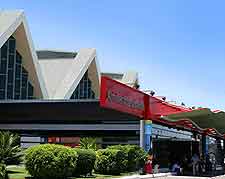
Since Madagascar lies some 400 km / 248 miles off the coast of
Africa, flying here is the only viable transport option for most tourists. The main island is fairly large (indeed, it rates as the fourth-largest island in the world), and so finding a way to travel around can sometimes be a challenge.
If time is limited, taking an organised tour of Madagascar may well be your best option for travelling between attractions. However, if you are able to stay for longer, then travelling in a more sedate fashion by public transport may offer more in the way of experiences. On the north-eastern coast, passenger ferries often operate, although boats are not generally considered to be a safe way to travel between May and September, since this is the rainy season.
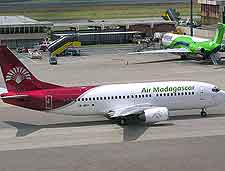
Ivato Airport (TNR) / Arriving by Air
Address: Lalana Dok Joseph Raseta, Antananarivo, Madagascar, MG, Africa
For most tourists, Ivato Airport is the first point of arrival in Madagascar. The airport is situated roughly 12 km / 7 miles north of the capital city of Antananarivo. A variety of international airlines fly to and from the country, with Air Madagascar being the biggest airline by far. Other airlines include the likes of Air Austral, Air France, Air Mauritius, Comores Aviation, Corsairfly, Kenya Airways and South African Airways.
From Europe,
Paris is the main hub for planes to Madagascar. Other prominent airports include those situated at Mahajana and Toamasina. These tend to handle services from
Mauritius and the Comoros islands.
Once you've arrived in Madagascar, domestic flights are a good way to travel around the country and its islands. Not only are they incredibly timesaving, meaning that you can avoid having to make long journeys by road or train, they are also relatively inexpensive.
The principal airports of Madagascar are listed below:
- Ambalabe Airport (WAI) - Antsohihy, Mahajanga
- Ambanja Airport (IVA) - Ambanja, Antsiranana
- Ambatomainty Airport (AMY) - Ambatomainty, Mahajanga
- Ambatondrazaka Airport (WAM) - Ambatondrazaka, Toamasina
- Ambilobe Airport (AMB) - Ambilobe, Antsiranana
- Amborovy Airport (MJN) - Mahajanga, Mahajanga
- Ampanihy Airport (AMP) - Ampanihy, Toliara
- Analalava Airport (HVA) - Analalava, Mahajanga
- Andapa Airport (ZWA) - Andapa, Antsiranana
- Ankaizina Airport (WBE) - Bealanana, Mahajanga
- Ankavandra Airport (JVA) - Ankavandra, Toliara
- Ankazoabo Airport (WAK) - Ankazoabo, Toliara
- Antsalova Airport (WAQ) - Antsalova, Mahajanga
- Antsirabato Airport (ANM) - Antalaha, Antsiranana
- Antsirabe Airport (ATJ) - Antsirabe, Antananarivo
- Antsoa Airport (WBO) - Beroroha, Toliara
- Arrachart Airport (DIE) - Antsiranana, Antsiranana
- Befandriana Avaratra Airport (WBD) - Befandriana-Avaratra, Mahajanga
- Bekily Airport (OVA) - Bekily, Toliara
- Belo Sur Tsiribihina Airport (BMD) - Belo sur Tsiribihina, Toliara
- Besalampy Airport (BPY) - Besalampy, Mahajanga
- Betioky Airport (BKU) - Betioky, Toliara
- Doany Airport (DOA) - Doany, Antsiranana
- Farafangana Airport (RVA) - Farafangana, Fianarantsoa
- Fascene Airport (NOS) - Nosy Be, Antsiranana
- Fianarantsoa Airport (WFI) - Fianarantsoa, Fianarantsoa
- Ihosy Airport (IHO) - Ihosy, Fianarantsoa
- Ilaka Est Airport (ILK) - Ilaka-Est, Atsinanana, Toamasina
- Ivato Airport (TNR) - Antananarivo, Antananarivo
- Mahanoro Airport (VVB) - Mahanoro, Toamasina
- Maintirano Airport (MXT) - Maintirano, Mahajanga
- Malaimbandy Airport (WML) - Malaimbandy, Toliara
- Mampikony Airport (WMP) - Mampikony, Mahajanga
- Manakara Airport (WVK) - Manakara, Fianarantsoa
- Mananara Nord Airport (WMR) - Mananara Nord, Toamasina
- Mananjary Airport (MNJ) - Mananjary, Fianarantsoa
- Mandabe Airport (WMD) - Mandabe, Toliara
- Mandritsara Airport (WMA) - Mandritsara, Mahajanga
- Manja Airport (MJA) - Manja, Toliara
- Maroantsetra Airport (WMN) - Maroantsetra, Toamasina
- Miandrivazo Airport (ZVA) - Miandrivazo, Toliara
- Morafenobe Airport (TVA) - Morafenobe, Mahajanga
- Morombe Airport (MXM) - Morombe, Toliara
- Morondava Airport (MOQ) - Morondava, Toliara
- Port Bergé Airport (WPB) - Port Bergé, Mahajanga
- Sainte Marie Airport (SMS) - Ile Sainte Marie / Nosy Boraha, Toamasina
- Samangoky Airport (TDV) - Tanandava, Toliara
- Sambava Airport (SVB) - Sambava, Antsiranana
- Soalala Airport (DWB) - Soalala, Mahajanga
- Tambohorano Airport (WTA) - Tambohorano, Mahajanga
- Toamasina Airport (TMM) - Toamasina, Toamasina
- Tolanaro Airport (FTU) - Tolanaro (Tolagnaro), Toliara
- Toliara Airport (TLE) - Toliara, Toliara
- Tsaratanana Airport (TTS) - Tsaratanana, Mahajanga
- Tsiroanomandidy Airport (WTS) - Tsiroanomandidy, Antananarivo
- Vatomandry Airport (VAT) - Vatomandry, Toamasina
- Vohemar Airport (VOH) - Vohemar, Antsiranana
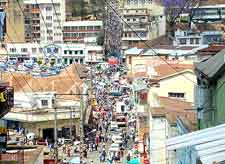
Car Rental
Madagascar's road network isn't in a particularly good condition. Whilst most major roads are paved, such as the one that runs between Antananarivo and Tamatave, they are usually quite busy. Drivers should therefore take particular care. Antananarivo's narrow streets have to be shared with plenty of buses and cars, especially during the morning and evening, and over lunchtime, so care is needed if you are using your car to get around the city.
Those wishing to rent a car as their chosen mode of transport will need to be in possession of an International Driving Permit and be aged at least 23 years old. Air-conditioned cars are essential, and if you are intending to head off the main routes, a 4WD vehicle is strongly advised. Also worth bearing in mind is the rainy season, which can make driving on some roads quite treacherous, paticularly those with bad potholes.
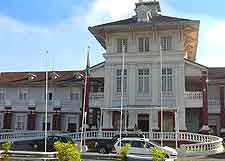
Buses and Coaches
Public buses operate between some cities in some parts of Madagascar, such as from Antananarivo to Toamasina. Bus services also operate in and around larger urban areas. Public transport by bus remains fairly crowded, unreliable and slow. A flat fare is charged, which covers journeys no matter how long or short. Various long-distance buses travel along the Tamatave and Toliar routes, such as MadaBus.
Trains
Madagascar's railway network comprises five different services. These include train links to and from Antananarivo, Toamasina, Fianarantsoa, Manakara, Antsirabe and Moramaga. Most of these are freight trains and only a handful of routes run regular, reliable passenger services. Trains can be a little slow at times, and not always very comfortable, although you can of course sit back and admire the spectacular scenery passing by the window, which is at its best between Fianarantsoa and Manakara.
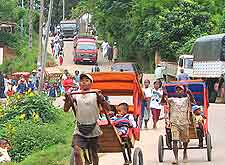
Taxis
If you need to travel cross country between towns, then a bush taxi, or 'taxi-brousse', is your best bet. They may not be the quickest way of travelling around Madagascar, but they are fairly inexpensive compared to hiring a car, and are quite comfortable. Flat fares are charged outside of Antananarivo and Fianarantsoa - don't forget to agree the fee in advance to avoid nasty surprises when you reach your destination. If speed is of the essence, taking a 'taxi-be' is a better option. These taxis are similar to bush taxis, but are generally more comfortable and faster.
A trip in a 'pousse-pousse', one of Madagascar's colourful hand-pulled rickshaw taxis, makes for an interesting experience. There are generally plenty of these outside railway stations. However, their pullers can often be persistent and overpowering if you've just stepped off a train.
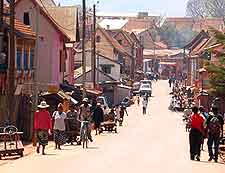
Bike
Mountain bikes are a great way to get around if you've got a reasonable level of fitness. They benefit from being able to deal with terrain that ranges from muddy to rocky. If your starting point is too far to ride, then it is usually possible to transport your cycle by train or by bush taxi. Mountain bikes can be hired on a daily basis from many large towns and cities, although the condition of bikes on offer does vary widely.
 Since Madagascar lies some 400 km / 248 miles off the coast of Africa, flying here is the only viable transport option for most tourists. The main island is fairly large (indeed, it rates as the fourth-largest island in the world), and so finding a way to travel around can sometimes be a challenge.
Since Madagascar lies some 400 km / 248 miles off the coast of Africa, flying here is the only viable transport option for most tourists. The main island is fairly large (indeed, it rates as the fourth-largest island in the world), and so finding a way to travel around can sometimes be a challenge.




